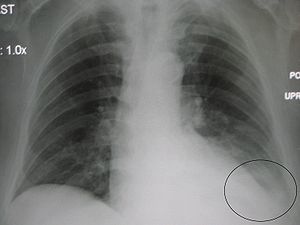
Parapneumonic effusion

A parapneumonic effusion is a type of pleural effusion that arises as a result of a pneumonia, lung abscess, or bronchiectasis. There are three types of parapneumonic effusions: uncomplicated effusions, complicated effusions, and empyema. Uncomplicated effusions generally respond well to appropriate antibiotic treatment. A parapneumonic effusion is a type of pleural effusion that arises as a result of a pneumonia, lung abscess, or bronchiectasis. There are three types of parapneumonic effusions: uncomplicated effusions, complicated effusions, and empyema. Uncomplicated effusions generally respond well to appropriate antibiotic treatment. The criteria for a complicated parapneumonic effusion include the presence of pus, Gram stain–positive or culture-positive pleural fluid, pleural fluid pH <7.20, and pleural fluid LDH that is greater than three times the upper limit of normal of serum LDH. Diagnostic techniques available include plain film chest x-ray, computed tomography (CT), and ultrasound. Ultrasound can be useful in differentiating between empyema and other transudative and exudative effusions due in part to relative echogenicity of different organs such as the liver (often isoechogenic with empyema). Appropriate management includes chest tube drainage (tube thoracostomy). Treatment of empyemas includes antibiotics, complete pleural fluid drainage, and reexpansion of the lung.Other treatments include the use of decortication.
